![]()
Return to Index/Main Page
| A lexicon of knife terminology: Section S | ||||||||||||||||||||||||||
| Numbers | A | B | C | D | E | F | G | H | I | J | K | L | M | N | O | P | Q | R | S | T | U | V | W | X | Y | Z |
S30V: A registered trademarked steel of Crucible Industries LLC. It is more correctly called CPM S30V. It isstainless steel with a compostion of Carbon 1.45%, Chromium 14.00%, Vanadium 4.00%, Molybdenum 2.00%. The Steel was developed by Dick Barber of Crucible Materials Corporation in collaboration with knifemaker Chris Reeve. CPM S30V is considered one of the Super Steel and is normally found in high-end tactical knives.
Saddle Horn: A traditional pattern folding knife; in which the pommel is widened and upswept to resemble a saddle horn. A common style used in folding hunters and trappers. The pommel will normally not have a bolster.
Sailor’s knife: A knife used by sailors, normally with a sheepfoot blade. It may be a folding or fixed blade knife. Also called a rigger or rigging knife. See Rigger for more details
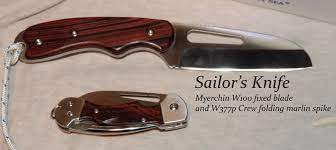
Sailor’s tool: Normally a riggers knife in which one end is equipped with pliers with the knife handle and marlin spike acting as the legs of the pliers. The term is also used to describe any Rigger as described in Rigger’s Knife, definition number 2.
Saw Blade: A blade with a serrated edge used normally for cutting small pieces of wood.
Scabbard: A case or sheath designed to protect the blade of a knife, bayonet or sword. Scabbards are often made of hard, inflexible materials. As the scabbard is designed to just protect the blade, it normally requires a frog or other similar device in order to be attached to a belt. Most modern bayonet scabbards (such as the M8 and M8a1 used to carry WWII – present day American bayonets) are “integrated scabbards” meaning the frog is permanently attached to the scabbard making it similar to normal knife sheath. (See Sheath)
Scale: On folding knives it is the outside part of the handle made of a material different than the handle and requires some type of mechanism, normally pins, screws or glue in order to be attached to the handle. They are often called handles. The obverse scale is usually the one in which a shield is inlaid. The reverse scale is the opposite side. On fixed blades knives with a visible full tang, scales are the handle material secured to either side of the tang.
Scaler: A blade used for scaling fish. It is often combined with a bottle opener and a hook remover. The blade has a serrated edge but is not sharp.
Scarce: An often ill-defined and therefore meaningless term used to sell knives; especially online.
Schrade: An old U.S. made knife brand currently manufactured in China. Schrade was originally part of the Imperial Knife family but went into receivership. The Trademark was bought by Taylor Brands LLC. And it is currently manufactured in China.
Schatt & Morgan: An American cutlery company currently owned by SMKW. Current S&M knives are made by Queen Cutlery.
Scissors: Just what it sounds like. Small folding scissors found on pocket knives.
Scout: A specific style of Boy Scouts of America folding pocket knife with four blades (A spear master, a punch, and can opener, and a caplifter/screwdriver. It is an equal end knife normally with a bail attached to the opposite end from the spear master. See also Utility and Camp
Screwdriver: A knife blade designed to loosen and tighten screws. Flat head screwdriver blades are normally found on a variety of utility knives. Old Rigger knives will sometimes have one built in the butt cap. Flat heads are often combined on blades with multiple uses. Phillips screw drivers as rarer but appear on many utility knives as a single blade.
Screw Punch: A punch that has screw type groove running its length so that it can be drilled through leather or wood
Scrimshaw: Hand carving done in bone or ivory, originally with a marline spike or sheepfoot blade. Today, mass produced scrimshaw work is done via laser etching. Most reputable dealers will differentiate between laser scrimshaw or etching and hand scrimshawing. The trained eye will notice imperfections and differing cutting depths in hand scrimshaw work.
Seahorse (Whittler): A whittler knife with a sleeveboard handle and a main wharncliffe blade. The secondary blades are normally a small pen and a coping. This was a pattern first seen on Case knives. See whittler and wharncliffe.

Search & Rescue: A type of folding knife, featuring a seat belt cutter and windshield breaker. The knife usually has a single large blade with a tanto or clip point and combination half fine/serrated edge. Most can be opened one handed and feature some type of assisted opening and a liner lock. Many are inexpensive knives with exotic offical sounding names leading one to beleive the military or first responders use such a knife. Also called SAR.
Second Cut Stag: Stag cut from the inside portion of the antler that is jigged to look like the outside portion of the stag. Second cut is general consider of lesser quality that regular stag , however Second Cut Stag does have a loyal following of fans.
Senator: A traditional pattern folding knife; a pen knife with a slender oval handle and two pen blades, one on each end. The main blade is normally long spear and secondary blade a small pen blade. Senators normally have bolsters on both ends. Compare to Eisenhower, congress, canoe, peanut, and jack.
Serpentine: and “S” shaped knife handle.
SFO -- Special Factory Orders: A term used by Smoky Mountain Knife Works to denote knives made by various American companies to their specifications and for sale through their store.
Shackle: The termed used in the Britons and the Commonwealth for a Bail, a small metal attachement used to attach a lanyard.
Shackle Key: A blade unique to folding Rigger’s Knives. It is a flat unsharpened blade with an elongated hole in the center that often narrows at the handle end of the blade. It is used for loosening shackles (butterfly like screw heads) on ships and boats. The shackle key is often built in to the end of marlin spikes making them look like large needles.
Sharpfinger: The trademarked name for the Schrade152Ot Upswept Skinner sold by Schrade (now owned by Talylor Brands). While other companies have made upswept skinners identical to the Sharpfinger, leaglly the name Sharpfinger only applies to the Schrade/Taylor Brands products. Other knives should be refered to as Sharpfinger like skinner or by the maker's name; such as the Camillus Grand Pa's Hunter.

Sheath: A purpose built case or covering designed to protect and often carry a knife; an integrated scabbard. While ill-defined, the sheath normally has integrated attachments (slots, loops, etc. allowing for easy attachment to the belt or body. If the case only protects the blade of the knife and needs the aid of another device for easy carrying, it is more rightly a scabbard. Traditionally the sheaths of bayonets and swords are called scabbards.
Sheepfoot: A type of blade where the tip is rounded all the way down to meet the bottom straight cutting edge. It is used for cutting rope, and carving wood. It is very common on nautical knives. The blade is named for its resemblance to a sheep’s foot. The blade is often called a sheep foot, sheep’s foot or sheepsfoot. Sheepfoot is the proper term according to W.R. Case & Sons.
![]()
Sheepfoot blade.
Short Pull: A short groove in the side of a knife blade to aid in opening. Also called a nail mark or nail nick.
Shucker: A small bladed knife designed specifically for opening oysters and other types of shellfish. Also called an Oyster Knife.

Silicon: Silicon is added to steel to increase its strength.
Single Action OTF: A spring assisted knife with a retractable blade that deploys point first from the knife's handle when some type of release such as a button ot lever is pressed. The blade must then be manually retracted into the handle by pulling back on the release which follows a channel that is cut into the handle. Also called an Automatic or Auto OTF (see Gravity Knife and Double Action OTF for comparison.
Skinner: A hunting knife that is designed for skinning animals. The term is very generic and skinning knives come in a variety of shapes and forms. One aspect of the skinner as the handle of the knife may be lacking a guard or will have a small guard that makes it more easier for the user to hold the blade. Skinners will often have thinner blades than general purpose camp knives and feature finger choils, and jimping on the spine to aid in controlling the blade. Compare to Fillet, Hunter, and Camp Knife.

Skinner blade: This refers to a blade profile where Tip comes up to meet the spine of the knife and their is no cleppign or downward movement of the spine. If the spine of the blade is turned and the sharpened edge also turnes up to meet the spine the blade is an upswept skinner blade. Compare to fillet, clip and tanto.
![]()
Skinner
Sleeveboard: A traditional handle design of English origin. The handle normally has rounded bolsters on both ends and is generally shaped like a man’s shirt sleeve, that is larger at the top end (where the main blade is attached) and slowly narrows to much smaller bottom end (where secondary blades are attached). In some cases the handle has a slightly convex shaped spine. The shape is common with Seahorse whittler.
Slider OTF: A knife with a retractable blade that deploys point first from the knife's handle. The blade is pushed forward manually using a release mechanism that follows a channel cut in the handle. The blade also manually retracted into the handle by pulling back on the release. The standard box cutter knife is an example of Double Action OTF. Also called a Doulbe Action OTF. (see Gravity Knife and Single Action OTF for comparison.
Slip-Joint, Slipjoint, Slip Joint:
Slip-joint refers to the spring used to hold the blade of folding blade in the open and closed position or a knife that use this type of spring in its construction. In a slip-joint knife it is the pressure of the back spring that holds the knife blade in the open and closed position and there is no actual locking mechanism other than spring tension. It is defining feature of many non-locking knives that are lumped into the vague category of Traditional Pattern Folders.
Slippy: A diminutive term for a slip-joint knife. A non-locking pocket knife
Small Game Hunter A small hunting knife, normally around 8 to 10 inches in over all length with a 4 to 5 inch blade. The blade is often has a clip or drop point. The knife will often have a half guard. See also Small Bowie, Skinner, Bushcraft, Bird & Trout.

A Small Game Hunter (Rough Rider 844)
Smokey Mountain Knife Works: A major retailer and distributor of Knives in the U.S. Their house brands include Rough Riders, Marbles and Indian Head to name a few. They also are a major distributor for Case Knives, including exclusive designs only available through them. They also own the Colonel Coon Trademark.
Smooth Bone: Bone handles that have been sanded smooth. Bone that has not been jigged or cut into patterns.
Snake Wood: Perhaps the heaviest, densest wood in the world, it is found in the South American rain forest and is used as a handle material
Snap: The sound a folding knife makes when it opens and closes. A good snap is loud and distinct
Sodbuster: W. R. Case & Son trademarked name for traditional pattern folding knife; normally a large framed work knife with simple smooth handles, lacking bolsters and containing a single skinning blade. Because Case holds the TM for the name, other companies use similar names to describe their Sodbuster like knives Some examples are Dirtbuster and Shotbuster. Another common name is the mule skinner.

Solingen: Steel manufactured in Solingen Germany. The quality of Solingen steel, like that of any steel depends on what foundry/company is doing the manufacturing. Therefore, being informed a knife is made with Solingen steel is meaningless unless other information is given. See surgical steel and Japanese Steel for comparison.
Sowbelly: A traditional pattern folding knife; normally a stockman with a thick bodied serpentine style handle.

Spatula: The secondary blade found on a Doctor’s Knife. It is a long, slender, unsharpened blade; often notched on both sides near the tang. The tip of the blade may be rounded or squared off. The blade is used for scooping powder or crushing pills. It is also used for applying ointments. The spatula also doubles as a tongue depressor; which is why it is relative thick and unsharpened.
![]()
Spatula
Spay: A spear point or pen blade that has had the tip sharply clipped from the top just below the center line in order to reduce the likelihood of skin puncture. The blade was originally used in animal castration but also proved an effective skinning blade.
![]()
Spay
Spear Point: A straight blade with a tip end that is a rounded sharp point. See also pen blade.
![]()
Spear Point
Speed Assist: see: Assisted Opening.
Spine:
1) The not sharpened edge of a blade, the back edge of a blade. The part visible when a the blade is folded into the knife.
2) the back of a knife. The part of a folding knife’s handle that houses the blade springs.
Split Blade: A blade split in the middle with the cutting surface appearing inside the split. It is an early form of can opener that can also be used to lesser extent for cutting line.
Split Back Spring: A design used in many traditional whittlers where a Vee shaped liner wedge is used to separate two springs so that the two secondary blades located at the butt end of the knife are worked off one spring and the main blade located at the top end of the knife is operated by both springs. When the blades are all folded, the split back spring allows the main blade to drop between to the two secondary blades.
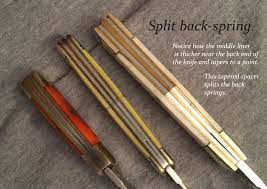
Spring: A metal bar, often made of the same steel as the knife blade that runs along the spine of the knife handles used to keep the blade in the open or closed position.
Spring Steel : 5160 Steel is often called spring steel because it was often used in the making of leaf springs for automobiles. It is aslo called Studebaker Steel because many knife makers used the steel specifically from the leaf springs of old Studebakers for knife blades. It is a carbon-chromium steel alloy, . It is a common sword steel, especially for European style swords but is also common among survival knives due its tougness. The compostion of 5160 is: Carbon - 0.56 - 0.64; Chromium - 0.7 - 0.9; Manganese - 0.75 - 1; Phosphorus - 0.035 max; Silicon - 0.15 - 0.35; and Sulphur - 0.04 max.
Spyderco: a company formed by Sal Glesser that specializes in high end tactical folding knives. With G10 or fiber glass reinforced handles. Glesser pioneered many of the common features of tac knives including pocket clips, thumb holes and torsion springs. There knives are made in the US, Taiwan, Italy Germany and Japan
Stacked leather: A type of knife handle found on fixed blade knives where rounded flat leather disks are glued and stacked from cross guard to pommel around the tang of the knife. The Air Force Survival Knife and the USMC fighting knife are famous for their stacked leather grips.
Stag: (Deer Antler) Stag refers to deer antler and is a high-end handle material used in traditional pattern folding and fixed blade knives. Stag used today normally comes from the dropped horns of Red Deer (Cervus elaphus) native to India and Pakistan. There are numerous ways to prepare stag for use in knife handles such as burning and using interior (second) cuts of the antler. Stag can also be dyed. Unfortunately, stag like many materials will vary in quality. Many knives made in Pakistan use stag for the handle material, however the quality of the stag is oftne inferior to the quality of stag found on premium knives made in the USA. In other words, you get what you pay for, even with stag.
Stagalon: Imitation stag made of a trademarked manmade material associated with Frost cutlery products. This is not the same as other materials that have been jigged to look like stag, such a stag jigged Delrin or stag jigged bone.
Stainless Steel: A steel chromium alloy with approximately 10% to 18% chromium added to the steel. Stainless steel will still rust or stain. It is just less prone to rusting and staining. A lower chromium level is normally ideal for blade steel but will be more prone to rusting.
Stanhope: Stanhope refers to a small micro-photograph that was made visble through the use of a small magnifying glass. The novelty viewing device was invented by René Dagron in 1857. Not soon afterwards the device was fixed into the handles of folding knives, especially Bartender knives. In the world of Knife collecting Stanhope refers to these such knives.
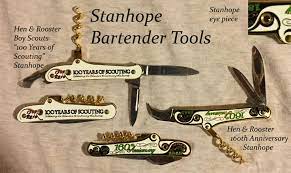
Steel: malleable alloy of iron and carbon.
Steel Warrior: A Frost family brand of knives normally made in China, considered a step above the regular Frost Brand knife. These normally have a Rockwell tested blade.
Stellite: 6K an expensive non steel alloy.
Stiletto: A type of dagger with a slender almost always double edged blade. In the case of folding knives, the top edge is normally has a false edge. Most folders will have assisted opening and will be lock blades.

Strength: A blade’s ability to take a load without permanently deforming (twisting or bending). See also Hardness and toughness.
Stockman: A traditional pattern folding knife; a three bladed knife that has a large clip and smaller sheepfoot at the top bolster and a small spay blade at the bottom bolster. Stockman's come in avariety of shapes and sizes with many companies have special names to describe the pattern. The pattern is sometimes called "Stock Knife" by some sellers. Other names for certain patterns are Cattle Knife, Cattleman, Cowboy, Range Rider, etc.
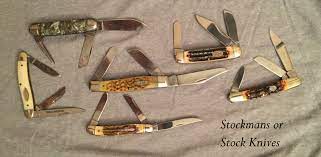
Sulfur: Sulfur is added to steel to make it easier to machine but is not desirable in cutlery steel as it creates a poor quality steel that will not hold up well even with everyday use.
Sunfish: A traditional pattern folding knife; a wide bodied equal end knife with a spear master blade rather wide secondary pen blade. The knife is called a sunfish because it has a flat, wide, stubby body similar that of a bluegill or pumpkinseed. The Sunfish is related to the Elephant Toenail, a pattern that predates it by a few years. Some collectors consider the Sunfish a variation of Elephant Toenail and use the names interchangeably. See Elephant Toenail for comparison. For the most part, people who collect Sunfish are very likely to collect Elephant Toenails as well.
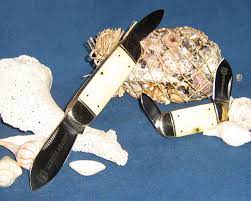
Rough Rider's Standard and Baby Sunfish in white smooth bone
Surgical Steel: Almost any type of stainless steel can be classified as “surgical steel” making the term surgical steel virtually meaningless. Surgical steels includes the 300 series or 18-8 Stainless which have a make up 18% chromium and 8% nickel. These steels are used in surgery for prosthetics, as well as surgical trays. They are also used for making dinner wear because they are very stain/rust resistant. 18-8 Stainless is virtually useless as a knife blade because edge retention is virtually non-existent. You can't sharpen it!
A quick test is a magnet test. 18-8 steel is so full of nickel, chromium or other alloys that it isn't even magnetic! However, there are some surgical steel that is magnetic and the quality is worse than the worst 420 Stainless, at least for knife blades.
The novice knife collector should assume that any knife passed off as surgical steel is no better than 420 even if it passes the magnet test. A better quality steel would be listed by an actual grade. The exception to this rule is if you already familiar with other knives of the same brand and know them to be of good quality.
The problem is some knife manufacturers will use varying grades of steel from year to year or even pattern to pattern and thus lump all of their blades under the generic and meaningless terms of “surgical steel” for easy of advertising. This is disservice to consumer and as a knife buyer you should complain to distributors and ask for a more accurate description of the steel used in production.
Survival Knife:A somewhat generic term for a knife used in extreme wilderness survival.
The hollow handled survival knife became extremely popular with the movie "First Blood" The first of the Rambo movies. The knife featured a large clip blade with a saw tooth spine, and a hollow handle with a variety of small survival tools such as string, needles, matches, etc. and screw on cap that featured a Compass.
At the other end of the spectrum is the U.S. Miltary issued 499 Air Force Survival Knife.
See also Camp Knife and Bushcraft knife.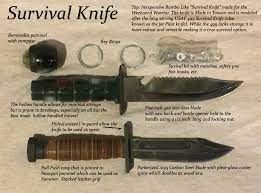
Swedge: an unsharpened false edge on the spine of a knife’s blade. Also called a false edge.
Swell: a knife handle in which the handles widens as it leaves the tang end of the knife and is noticeably large at the butt end.
Swing Guard: A traditional pattern folding knife; a knife style in which a quillion or guard is attached to the blade so that when the knife is folded the cross bar rests on top of the channel and when the blade is opened, the crossbar is held stationary at the top of the handle. (Same as a Cheetah)
Switchback: A name used be Camillus for their large toothpick knives in earlier years. This applied to both basic slipjoint and locking toothpicks
Switchblade: Any knife with a spring loaded blade that will open and lock in place when a switch or button is activated somewhere on the handle. Switchblades are illegal to sell or transport across state lines in the United States and their use is strictly limited. Compare to assisted opening.

Swiss Army Knife (SAK)
1) a generic term for any multi-function knife. It should be avoided.
2) Knives made by the Swiss Cutlery Companies, Victorinox and Wenger. Victorinox markets the “Original Swiss Army Knife”. Wenger markets the “Genuine Swiss Army Knife” Any multi-function not from these companies are more accurately called a multi-blade or sometimes "Swiss Style" knife.
Synthetic (Synth): A material chemically identical to the original but made by man. Not to be confused with Imitation. Turquoise, jasper, and mother of pearl are often synthesized and reputable dealers will clearly mark materials and synthetic. When dealing with knife handles, synthetics sometimes provide a better quality, less fragile handle than genuine stones; thus even top customizers may sometimes use synth stones in their knife handles. Compare to Imitation.
Return to Index/Main Page